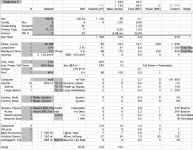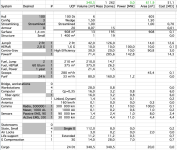There is an assumption among most Traveller players that the different rules all represent the same universe using different Game Mechanics. I always made that assumption. I have been recently reminded that “you can’t prove it from the Ship Design Rules”.
For me, the goal was something simple. I wanted to create a 100 dTon cylinder as a starting point for a low TL interplanetary shuttle (orbit to orbit). As a fortuitous coincidence, a real world rocket from 1968 happens to exist to use as a baseline for comparison: The SATURN II.
Let us ignore everything except for the HULL (no engines or minimal avionics) and create a 100 dTon hull using the various Traveller rules to compare the ships side by side.
So painting with a broad brush, all of the Traveller weights and volumes are in the same “order of magnitude” irrespective of rule system (for those systems that have them) and all are much higher than the Historic Rocket. The COSTS are all over the place with the CT:LBBs and MT most closely matching each other,CT Striker being a factor of 10 higher (and closest to Historic Rocket price) and TNE FF&S being a factor of 10 lower than the LBB prices.
Without comparing real and imaginary DRIVES and POWER PLANTS across editions, the "Hulls" alone appear to describe fairly significantly different realities from one another.
[I am not making any point beyond the observation that the rules are significantly different.]
EDIT: Correct CT Striker Prices (move decimal point 2 places) on 3/25/2023.
For me, the goal was something simple. I wanted to create a 100 dTon cylinder as a starting point for a low TL interplanetary shuttle (orbit to orbit). As a fortuitous coincidence, a real world rocket from 1968 happens to exist to use as a baseline for comparison: The SATURN II.
- 1968 Saturn II = 10m diameter x 25m tall = 140 dTons; 39 metric tonnes empty mass; $ 290 million. The five engines cost The inflation adjustment from 1968 to 1971 is small enough to ignore, so the cost is MCr 290.
Let us ignore everything except for the HULL (no engines or minimal avionics) and create a 100 dTon hull using the various Traveller rules to compare the ships side by side.
- CT LBB2:81 = 100 dTons; unk. Tonnes; MCr 10
- CT LBB5:80 = 100 dTons; unk. Tonnes; MCr 10
- CT Striker: TL 6 Hard Steel = 100 dTons; 1774 Tonnes; MCr 4.4; (222 cu. m. shell)
- MegaTraveller: TL 6 Hard Steel = 100 dTons; 1320 Tonnes; MCr 1.4
- TNE FF&S: TL 6 Hard Steel = 100 dTons; 1742 Tonnes; MCr 0.3; (218 cu. m. shell)
- CT Striker: TL 7 Composite Laminate = 100 dTons; 776 Tonnes; MCr 7.8; (111 cu. m. shell)
- MegaTraveller: TL 7 Composite Laminate = 100 dTons; 581 Tonnes; MCr 9.8
- TNE FF&S: TL 7 Composite Laminate = 100 dTons; 762 Tonnes; MCr 0.5; (109 cu. m. shell)
- CT Striker: TL 10 Crystaliron = 100 dTons; 554 Tonnes; MCr 5.0; (55 cu. m. shell)
- MegaTraveller: TL 10 Crystaliron = 100 dTons; 409 Tonnes; MCr 4.9
- TNE FF&S: TL 10 Crystaliron = 100 dTons; 545 Tonnes; MCr 0.3; (54 cu. m. shell)
- CT Striker: TL 12 Superdense = 100 dTons; 475 Tonnes; MCr 4.4; (32 cu. m. shell)
- MegaTraveller: TL 12 Superdense = 100 dTons; 211 Tonnes; MCr 4.4
- TNE FF&S: TL 12 Superdense = 100 dTons; 467 Tonnes; MCr 0.3; (31 cu. m. shell)
- CT Striker: TL 14 Bonded SD = 100 dTons; 238 Tonnes; MCr 4.4; (16 cu. m. shell)
- MegaTraveller: TL 14 Bonded SD = 100 dTons; 185 Tonnes; MCr 4.4
- TNE FF&S: TL 14 Bonded SD = 100 dTons; 233 Tonnes; MCr 0.3; (16 cu. m. shell)
So painting with a broad brush, all of the Traveller weights and volumes are in the same “order of magnitude” irrespective of rule system (for those systems that have them) and all are much higher than the Historic Rocket. The COSTS are all over the place with the CT:LBBs and MT most closely matching each other,
Without comparing real and imaginary DRIVES and POWER PLANTS across editions, the "Hulls" alone appear to describe fairly significantly different realities from one another.
[I am not making any point beyond the observation that the rules are significantly different.]
EDIT: Correct CT Striker Prices (move decimal point 2 places) on 3/25/2023.
Last edited:


